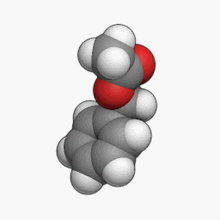Chemistry:Benzyl acetate

| |

| |
| Names | |
|---|---|
| Preferred IUPAC name
Benzyl acetate | |
| Identifiers | |
3D model (JSmol)
|
|
| ChEBI | |
| ChemSpider | |
| KEGG | |
PubChem CID
|
|
| UNII | |
| |
| |
| Properties | |
| CH 3C(O)OCH 2C 6H 5 | |
| Molar mass | 150.18 g/mol |
| Appearance | Colourless liquid |
| Odor | floral |
| Density | 1.054 g/ml |
| Melting point | −51.5 °C (−60.7 °F; 221.7 K) |
| Boiling point | 212 °C (414 °F; 485 K) |
| 0.31 g/100 mL | |
| Solubility | Soluble in benzene, chloroform Miscible with ethanol, ether, acetone |
| -93.18·10−6 cm3/mol | |
Refractive index (nD)
|
1.523 |
| Hazards | |
| NFPA 704 (fire diamond) | |
| Flash point | 102 °C (216 °F; 375 K) |
| 461 °C (862 °F; 734 K) | |
Except where otherwise noted, data are given for materials in their standard state (at 25 °C [77 °F], 100 kPa). | |
| Infobox references | |
Benzyl acetate is an organic ester with the molecular formula CH
3C(O)OCH
2C
6H
5. It is formed by the condensation of benzyl alcohol and acetic acid.
Similar to most other esters, it possesses a sweet and pleasant aroma, owing to which, it finds applications in personal hygiene and health care products. It is a constituent of jasmin and of the essential oils of ylang-ylang and neroli. It has pleasant sweet aroma reminiscent of jasmine. Further as a flavoring agent it is also used to impart jasmine or apple flavors to various cosmetics and personal care products like lotions, hair creams etc..[1]
It is one of many compounds that is attractive to males of various species of orchid bees. It is collected and used by the bees as an intra-specific pheromone; In apiculture benzyl acetate is used as a bait to collect bees. Natural sources of benzyl acetate include varieties of flowers like jasmine (Jasminum), and fruits like pear, apple, etc.[2]
References
- ↑ "Benzyl acetate". The Good Scents Company. http://www.thegoodscentscompany.com/data/rw1001611.html.
- ↑ Schiestl, F.P.; Roubik, D.W. (2004). "Odor Compound Detection in Male Euglossine Bees". Journal of Chemical Ecology 29 (1): 253–257. doi:10.1023/A:1021932131526. PMID 12647866.
External links
 |


